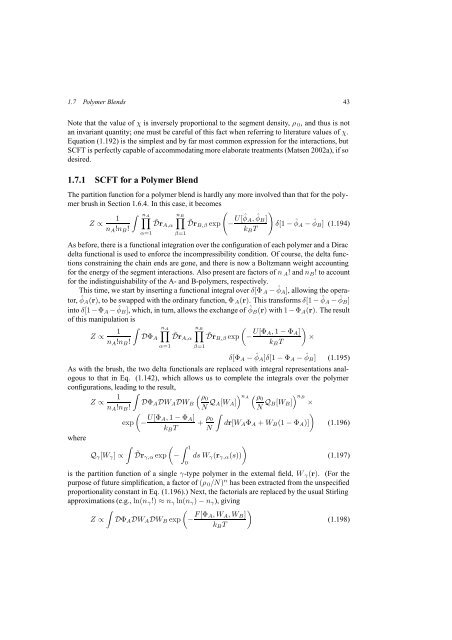Self-Consistent Field Theory and Its Applications by M. W. Matsen
Self-Consistent Field Theory and Its Applications by M. W. Matsen
Self-Consistent Field Theory and Its Applications by M. W. Matsen
You also want an ePaper? Increase the reach of your titles
YUMPU automatically turns print PDFs into web optimized ePapers that Google loves.
1.7 Polymer Blends 43<br />
Note that the value of χ is inversely proportional to the segment density, ρ 0 , <strong>and</strong> thus is not<br />
an invariant quantity; one must be careful of this fact when referring to literature values of χ.<br />
Equation (1.192) is the simplest <strong>and</strong> <strong>by</strong> far most common expression for the interactions, but<br />
SCFT is perfectly capable of accommodating more elaborate treatments (<strong>Matsen</strong> 2002a), if so<br />
desired.<br />
1.7.1 SCFT for a Polymer Blend<br />
The partition function for a polymer blend is hardly any more involved than that for the polymer<br />
brush in Section 1.6.4. In this case, it becomes<br />
∫ nA<br />
(<br />
1 ∏ ∏n B<br />
Z ∝<br />
˜Dr A,α<br />
˜Dr B,β exp − U[ ˆφ A , ˆφ<br />
)<br />
B ]<br />
δ[1 −<br />
n A !n B !<br />
k B T<br />
ˆφ A − ˆφ B ] (1.194)<br />
α=1<br />
β=1<br />
As before, there is a functional integration over the configuration of each polymer <strong>and</strong> a Dirac<br />
delta functional is used to enforce the incompressibility condition. Of course, the delta functions<br />
constraining the chain ends are gone, <strong>and</strong> there is now a Boltzmann weight accounting<br />
for the energy of the segment interactions. Also present are factors of n A ! <strong>and</strong> n B ! to account<br />
for the indistinguishability of the A- <strong>and</strong> B-polymers, respectively.<br />
This time, we start <strong>by</strong> inserting a functional integral over δ[Φ A − ˆφ A ], allowing the operator,<br />
ˆφ A (r), to be swapped with the ordinary function, Φ A (r). This transforms δ[1 − ˆφ A − ˆφ B ]<br />
into δ[1 − Φ A − ˆφ B ], which, in turn, allows the exchange of ˆφ B (r) with 1 − Φ A (r). The result<br />
of this manipulation is<br />
Z ∝<br />
1<br />
n A !n B !<br />
∫<br />
DΦ A<br />
n A<br />
∏<br />
α=1<br />
˜Dr A,α<br />
n B<br />
∏<br />
β=1<br />
(<br />
˜Dr B,β exp − U[Φ )<br />
A, 1 − Φ A ]<br />
×<br />
k B T<br />
δ[Φ A − ˆφ A ]δ[1 − Φ A − ˆφ B ] (1.195)<br />
As with the brush, the two delta functionals are replaced with integral representations analogous<br />
to that in Eq. (1.142), which allows us to complete the integrals over the polymer<br />
configurations, leading to the result,<br />
∫<br />
1<br />
( ρ0<br />
)<br />
Z ∝ DΦ A DW A DW B<br />
n A !n B !<br />
N Q nA<br />
( ρ0<br />
)<br />
A[W A ]<br />
N Q nB<br />
B[W B ] ×<br />
(<br />
exp − U[Φ A, 1 − Φ A ]<br />
+ ρ ∫<br />
)<br />
0<br />
dr[W A Φ A + W B (1 − Φ A )] (1.196)<br />
k B T N<br />
where<br />
∫<br />
( ∫ 1<br />
)<br />
Q γ [W γ ] ∝ ˜Dr γ,α exp − ds W γ (r γ,α (s))<br />
(1.197)<br />
0<br />
is the partition function of a single γ-type polymer in the external field, W γ (r). (For the<br />
purpose of future simplification, a factor of (ρ 0 /N ) n has been extracted from the unspecified<br />
proportionality constant in Eq. (1.196).) Next, the factorials are replaced <strong>by</strong> the usual Stirling<br />
approximations (e.g., ln(n γ !) ≈ n γ ln(n γ ) − n γ ), giving<br />
∫<br />
(<br />
Z ∝ DΦ A DW A DW B exp − F [Φ )<br />
A,W A ,W B ]<br />
(1.198)<br />
k B T
















